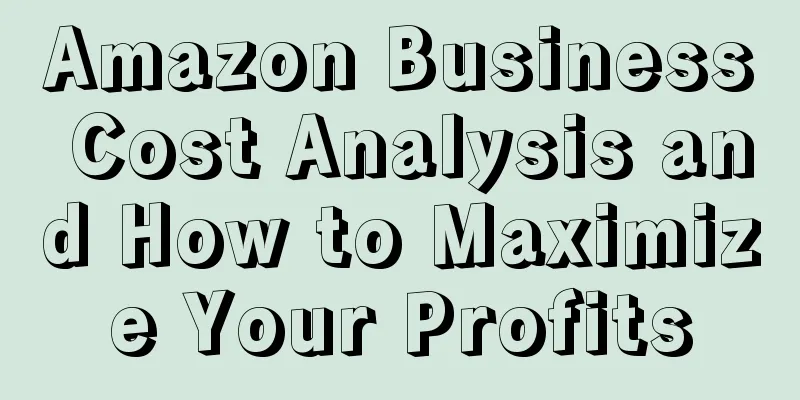Amazon Business Cost Analysis and How to Maximize Your Profits

|
Amazon is a very profitable sales channel for sellers. But like other channels, Amazon also has associated selling fees. Sellers need to have a clear understanding of the fees. To guide sellers, this article will detail how to determine your Amazon business costs and how to create the most profit: 1 Amazon selling fees Amazon has two types of sellers: professional sellers and individual sellers. Individual sellers do not need to pay monthly fees, but they need to pay $0.99 for each item sold, and then pay transaction fees. Professional sellers need to pay a monthly fee of US$39.99, and category commissions and transaction fees range from 6% to 25%. 1. Monthly rent If the number of products sold per month is greater than 40, you can apply to become a professional seller, and the monthly store rent is $39.99 2. Individual sellers Individual sellers need to pay a fee of $0.99 for each product they sell. 3. Commission The commissions vary from category to category. Some categories have a minimum commission for each product. The commission rate ranges from 6% to 20%, and the minimum commission is between $0 and $1. The minimum commission for jewelry and watches is $2. 4. Freight and transaction fee Products such as books, music, DVDs, and games are subject to a transaction fee. The shipping and transaction fees vary depending on the product category, delivery location, and courier method. 5. FBA Fees Amazon FBA service charges fees, and you can use tools (such as https://fees.sellerlocker.com/) to calculate your FBA fees. In addition to Amazon selling fees, sellers also need to be concerned about other expenses and think about the problem from a multi-dimensional perspective. The reason why many sellers fail on Amazon is because they only measure profitability from one dimension. Your profitability can only be effectively evaluated from multiple dimensions, which is what we call multidimensional methodology. The multidimensional methodology can help you determine the profitability of your SKU and help you make wise business decisions, including how to price, manage inventory, and stock up. Below are the most effective ways to evaluate the profitability of your Amazon business, helping you get the most profit from every penny you invest. 2 Methods for Assessing Amazon Business Profitability 1 Know your costs If someone asks you about the cost of a SKU, can you tell them? Even experienced sellers sometimes get tongue-tied and can’t put their finger on it. Now let’s look at the basic costs in business : 1. Direct costs The purchase cost of each SKU and the shipping cost. 2. Indirect costs Warehouse and office costs, insurance, wages and benefits, business taxes, etc. 3. Amazon fees Commission, FBA fees, FBA first-leg fees, commission for returned products, storage fees, return shipping fees, return shipping fees, etc. 4. Return processing costs Fees required to process returned products. (1) Determine the indirect cost per unit sold Take your indirect costs for the past 12 months and divide them by the number of units sold during that period to get your indirect costs per unit sold. You can update this figure every six months. Generally speaking, the indirect cost per unit sold is between $1 and $3. If your indirect cost is higher than this, you need to re-evaluate and determine how to simplify your costs. For example, if a toy costs hundreds of dollars per month to advertise, but the return on investment is 3 sales per month, you need to determine whether the toy is worth continuing to sell. (2) Amazon business costs A breakdown of Amazon fees can be found in Seller Central > Reports > Payments. FBA fees will be higher for larger products, and be sure to monitor slow-moving SKUs, as old inventory will incur additional fees. Certain SKUs have specific Amazon fees. Once you have calculated the cost for each SKU, average it out for each unit sold. This is a very simple way to calculate profitability and monitor cost information on a daily or monthly basis. To summarize, your costs include: wholesale costs, shipping costs, Amazon commissions, FBA fees, indirect costs, return fees, etc. If your SKUs are not consistently profitable, then you need to make necessary changes to your purchasing and inventory. Understanding your indirect costs per unit sold, the cost impact of returns, and SKU profitability can make you a smarter seller. For example, if a product has low FBA fees, low indirect costs, and good sales, then you can continue to order it. Otherwise, you should consider whether to stop purchasing or even remove the FBA goods. Many sellers use third-party software to automatically calculate the profitability of their products. 2 Factors causing profit loss 1. Returns Some products may have a high return rate, and if the buyer does not open the product, it can be put on the shelf as a new product. Some products have a low return rate, but the returned products cannot be resold, such as underwear. If the returned product can only be sold second-hand, a write-down cost will be incurred because second-hand products are priced lower than new ones. In addition to tracking the return rate of each SKU, you should also record the return cost. This data can be obtained in the Seller Central report or third-party software. It is crucial to monitor return rates and return costs because sometimes the return costs are so high that you need to consider removing the product. Removing products with high return costs can save your business profits. 2. Out of stock Even experienced sellers run into stockouts, which is a major factor that can reduce profitability. Let’s take a look at how much a stockout can cost. For example, an Amazon sports goods seller has more than 5,000 products, and its best-selling product is high-end soccer cleats. The average monthly sales of this product is 60 units, with a profit of $50. Assuming this product is out of stock for an average of 2.5 days per month, this amounts to a loss of $1,500 per year (2.5×50×12). How to prevent stock-outs: Scenario 1: Increased customer demand Changes in demand are unpredictable, and you never know whether a photo posted by an internet celebrity will cause consumers to snap up the item crazily one day. How to prevent this out-of-stock situation: First, look at your product type. The influencer effect is hard to predict, and what you can do is to purchase more inventory to prepare for a rainy day. But this solution may lead to an increase in FBA fees. Scenario 2: Seasonal changes For example, at the beginning of spring, sales of boots will decline, while sales of umbrellas, rain boots and slippers will begin to soar. Sellers who are not prepared may encounter out-of-stock problems. How to prevent this out-of-stock situation: If you sell seasonal products, monitor historical sales changes and pay attention to factors that cause sales changes, such as weather, so as to accurately predict inventory. Scenario 3: Supplier Issues Sometimes there will be problems with suppliers stopping supply or out of stock. How to prevent this out-of-stock situation: Make sure you are your supplier’s best customer and be able to communicate with them at any time so that you can learn about any changes in their product lines in advance and adjust your strategy. Even if some best-selling products are about to be discontinued, you can purchase more inventory if you know the information in advance, which will bring you more profits. Scenario 4: Competition leads to changes in demand For example, if your competitor's product is suddenly out of stock, consumers turn to buying your product, but because the stock is insufficient, the demand cannot be met. How to prevent this out-of-stock situation: Regularly monitor SKU sales so you can adjust your strategy as soon as possible. Depending on your competitors’ prices, you can increase your prices appropriately to gain more profits. 3 Know the profit-related indicators KPIs are key to the success of a business. They can help you evaluate whether you have achieved key goals and discover trends or problems. The following are important KPIs for evaluating the health of your Amazon business: 1. Inventory-to-sales ratio This metric shows the health of inventory and sales rate. 2. Inventory turnover rate Inventory turnover rate refers to the ratio of the total amount (total quantity) of goods shipped out during a certain period of time to the average amount (or quantity) of inventory during that period of time. A low turnover rate indicates poor sales, resulting in excess inventory. 3. Gross Margin Return on Investment (GMROI) This indicator is used to measure the profitability of inventory on the spot, and a value above 1 indicates that sales exceed total costs. 4. Cash Conversion Cycle This refers to the cycle from cash to production, sales, and then conversion to cash. This indicator measures the time required to sell inventory, the time required to collect cash, etc. The longer the cycle, the more disadvantageous it is. 5. Inventory Days The number of days it takes for a company to acquire inventory/products from the time they are put into storage until they are consumed and sold. This metric is very useful in helping you determine purchase quantities to ensure that you do not store too much or too little inventory. 4 Profitability loopholes and how to squeeze out more profits Some loopholes may seem insignificant, but they can have a decisive impact on your business. Here are some of the profit loopholes that Amazon sellers will encounter: Lost or Damaged Returns : Products returned by customers are lost or damaged during shipping. Amazon did not receive all of your goods: Some of the goods may be lost or damaged when shipped to the Amazon FBA warehouse. Therefore, it is necessary to confirm that the delivery and receipt are consistent. The SKU quantity sent by the supplier is incorrect : Be careful to check the supplier's shipping quantity. Now that you know the profit loopholes and indicators to watch, let’s talk about how to get the most out of every penny invested: 1. Negotiate with suppliers You can get better payment terms by leveraging sales and partnerships. 2. Product procurement Through the previous content, you learned about the SKUs with the highest profits, and you can use this data to make purchasing decisions. Note that the more diverse the product portfolio, the lower the risk of reduced profits due to reasons such as production discontinuation. 3. Historical profit trends If sales of a particular product have been declining, consider reordering the product. All products have a life cycle, and you need to pay attention to the trends.
The sales volume exploded in 7 months. This hot seller has something to tell you. Is Amazon right for you? To do business on Amazon, sellers must have these information and skills! How to choose the Amazon sales model that suits you 15 Reasons Why Your Amazon Account May Be Blocked Amazon Product Selection: How to Find Products That Sell Well When doing business on Amazon, be careful to avoid these traps A Brand Seller’s Guide to Amazon Business Strategy Take over the Buy Box, the battleground for sellers, in five minutes Amazon e-commerce tycoon shares his experience, why not save it? 2019 Amazon SEO Optimization Reference Guide How to Think about Amazon Listing Optimization from the Buyer’s Perspective Explore the successful path of private label sellers to earn tens of millions per year If you don’t do these four things well, Amazon’s business will be just a paper operation Text ✎ Mary/ Statement: When reprinting this article, the title and original text must not be modified, and the source and original link must be retained. |
<<: If you don’t do these four things well, Amazon’s business will be just a paper operation
>>: These 6 brands use it to improve customer experience and increase store conversion rates
Recommend
Is Amazon planning to establish a payment connection? Is the biggest wave of store closures in history coming?
The brand association incident happened not long ...
Your 2018 LD flash sale is about to end...
Cross-border Business School Information and skil...
In the crazy 2024, a large number of cross-border sellers are struggling to survive
Before we knew it, 2024 is coming to an end. Looki...
What is Moat? Moat Review
Moat is a company that helps companies measure the...
What is BlueOcean Pay? BlueOcean Pay Review
BlueOcean Pay was founded at the end of 2017. It i...
Amazon has integrated high-end gameplay, and new products can easily increase sales!
As we all know, new products face certain challeng...
FedEx plans to lay off five warehouse employees after strike
FedEx will lay off 843 employees at five warehouse...
How to create Amazon titles to increase product exposure and sales?
Efficient organization and optimization of produc...
Amazon Listing Optimization Product Q&A
1. What is Q&A Q&A, or Customer Questions ...
Want to increase Amazon warehouse delivery speed? You can expand your sales channels in this way
The logistics congestion caused by the canal accid...
DHL invests $78 million to expand Miami International Airport! Improve international service capabilities!
According to foreign media reports, DHL announced ...
What is K5 Warehousing Software? K5 Warehousing Software Review
K5 Warehousing Software is a product of Shenzhen Y...
I created nearly 6 million yuan in profit for the company in a year and a half. How much basic salary can I get in a new job with such a record? The current company's behavior makes me feel cold...
Anonymous user My C position This company, which ...
FedEx invests in FourKites to build smart supply chain platform! Amount not disclosed!
<span data-shimo-docs="[[20,"获悉,6月21日联邦快递公...









